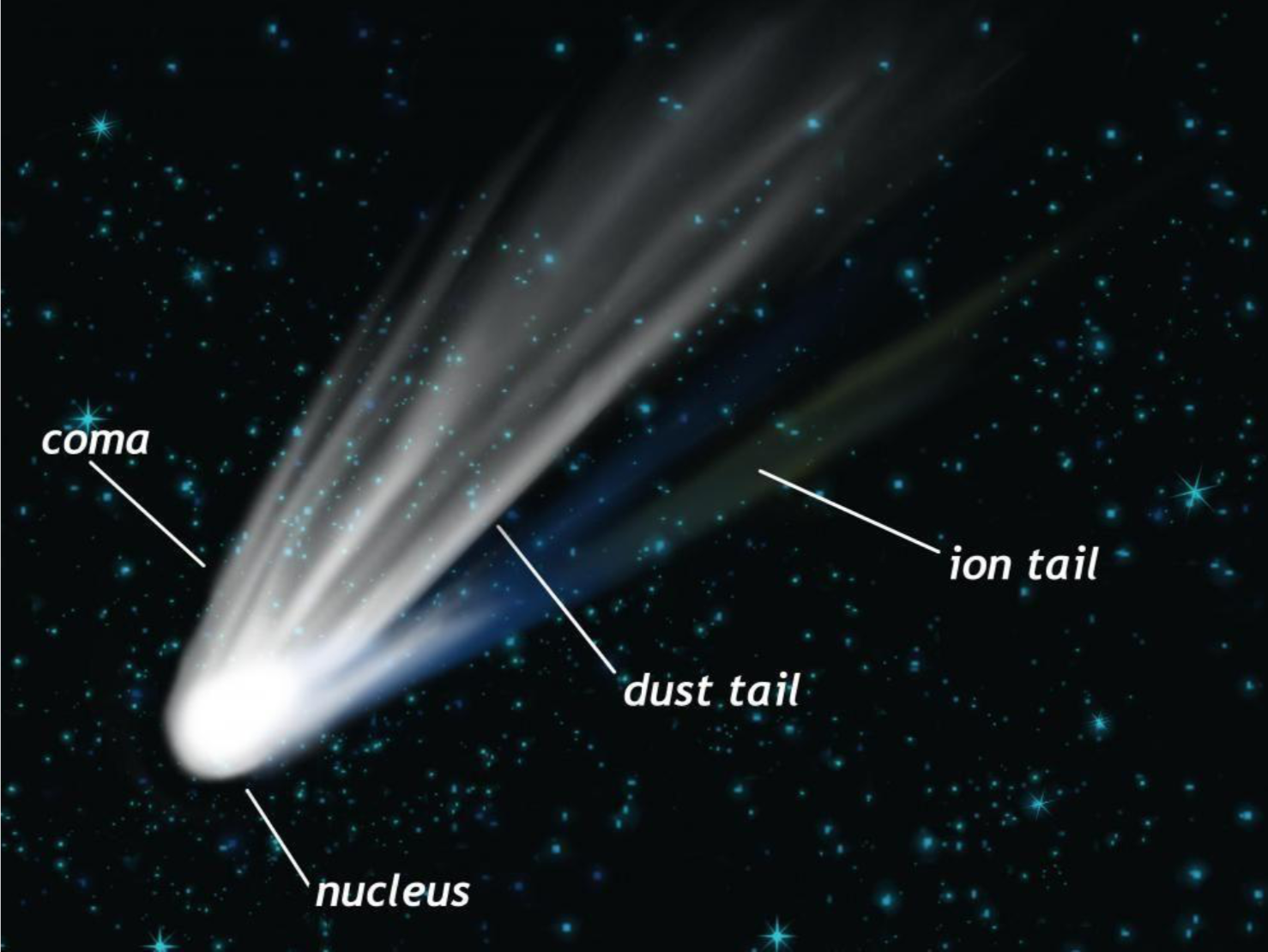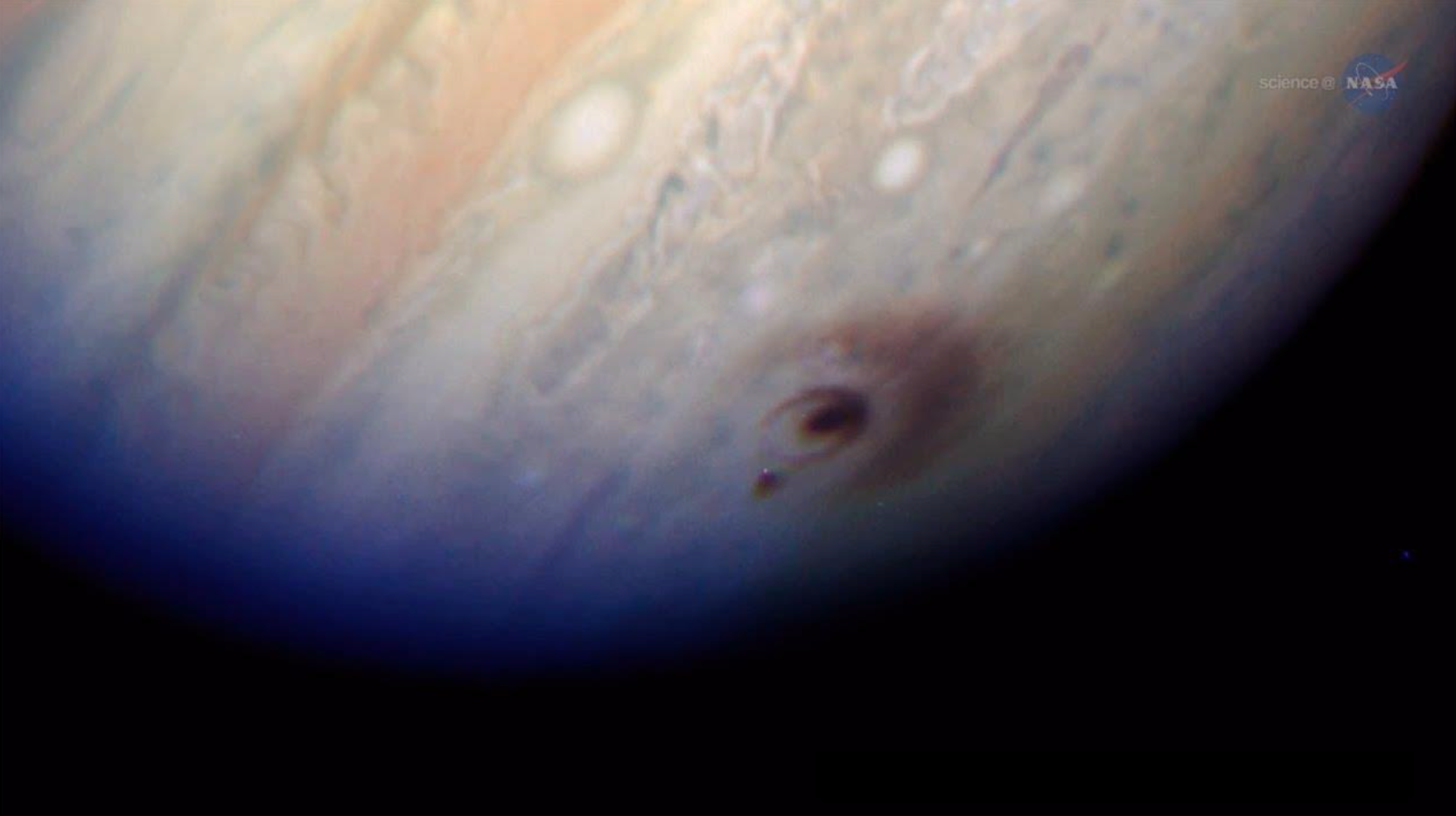Rocky Visitors, Part 3: Comets
Comets are beautiful, ancient wonders that travel through space. For thousands of years, we have been fascinated by comets and have never stopped looking up at the night sky in search of them. In fact, many of the comets we see today are the same ones our ancestors spotted long ago! But what even are comets? Are they stars? Giant boulders? Aliens? In this third part of the Rocky Visitors series, we’ll be answering this question, as well as exploring some of the Solar System’s most spectacular comets.
So, what are comets? Comets are basically giant, glowing space snowballs. If you’ve ever seen a comet, you might’ve noticed a long, dazzling tail. This is actually because of ice inside the comet. The center of a comet, called the nucleus, is made up of mostly ice and dust. When this comet nucleus approaches the sun, the ice begins to melt, which then causes the trapped dust to be released into space. This dust surrounds the comet’s nucleus in a glowing aura called a coma. It also curls behind the comet, forming a beautiful dust tail. In fact, comets have two tails – the second tail is called the ion tail and is made up of electrically charged particles called ions.
Here’s a diagram of the parts of a comet!
Maybe the most fascinating thing about comets is how far these tails stretch. Dust tails are usually between 600,000 to 6 million miles long, while ion tails are even longer – they are around 60 million miles long! Comet Hyakutake, also known as the Great Comet of 1996, carries the record for the longest tail ever seen on a comet. Hyakutake’s tail is at least 360 million miles long, which is nearly four times the distance from the Earth to the sun!
An image of Comet Hyakutake, taken on December 16, 2009. Look at how long its tails are!
Where do comets come from?
Comets usually come from two places – the Oort Cloud or the Kuiper Belt. The Oort Cloud, if it actually exists, is a huge region of billions (maybe even trillions!) of mostly comets that stretch far into space. Other stars sometimes nudge comets in the Oort Cloud with their gravity, which can cause their orbits to get closer to the Sun and Earth. When they get closer, we can sometimes see them in the night sky! But there’s actually no direct evidence that the Oort Cloud is out there. This means that no one has seen it with any sort of telescope. But astronomers are pretty sure it exists because it would explain where a lot of the comets that whiz by the Earth come from.
Here’s a diagram of the Kuiper Belt and the Oort Cloud. Both clouds are actually much farther from the sun in reality – if they were drawn to their true scale, they’d go all the way off the page!
Comets also come from the Kuiper Belt. The Kuiper Belt is also a group of billions of comets, and it begins past Neptune. Just like with the Oort Cloud, comets in the Kuiper Belt can sometimes get nudged away and then pulled closer to the Sun. Usually, big planets like Jupiter or Saturn do this, because they have a lot of gravity.
What do comets do?
You might have distant relatives who you get to see sometimes. If you have some, try to imagine being with them – you enjoy their presence when you visit, but you guys eventually have to leave, only to wait a long time to see each other again. Comets are just like this. They’re gone for a really long time, but when they come back, they are very beautiful and lovely to see, even though they only visit for a short while. In other words, comets have periods, and they’re often really long. A period is just how long it takes something to happen – in this case, how long it takes a comet to orbit around the sun and come back to Earth so we can see it again. So, like the other planets in our Solar System, comets orbit around the sun. This is why our ancestors saw many of the same comets we see today!
But comets take a really long time to complete their orbits, meaning they have really long periods. Comet West, which we last saw in 1975, holds the record so far for the comet with the longest period. It’s only visible from Earth every 250,000 to 550,000 years! Comets can be broken down into two categories based on their periods. Ones that take more than 200 years to complete an orbit are called long-period comets, while ones that take less than 200 years are called short-period comets.
What are some examples of comets?
Here are three spectacular comets of our Solar System and some awesome facts about them:
Comet Halley
Comet Halley is maybe the most famous comet ever. Throughout history, it has been spotted many times by many civilizations. The first ones to record it were the Chinese in 240 BC. That’s more than 2000 years ago! But it’s called Halley’s Comet because, in 1705, English astronomer Edmund Halley made discovered that it had a period of 76 years. The last time we got to see Halley’s Comet was from 1985 to 1986. Based on that, try to figure out when we’ll see it again!
Also, Halley’s comet is a Great Comet, which means it is exceptionally bright and can be seen with the naked eye.
On the left is an image of Comet Halley taken in 1986. The diagram on the right shows how Comet Halley orbits around the sun.
Comet Shoemaker-Levy 9
Sometimes, though, some comets just don’t make it. This was the case with Comet Shoemaker-Levy 9. In 1992, it flew too close to Jupiter and was torn up into more than twenty pieces. This happened because Jupiter’s gravity is so strong. Then, slowly, but surely, it started to fall into Jupiter, and in 1994, finally burnt up in its atmosphere. Here’s the crazy part – when these chunks collided with Jupiter, they exploded with more energy than 300 million atomic bombs! This collision left a dark mark (like a bruise!) on Jupiter, which lasted for many months.
Here’s the mark that Shoemaker-Levy 9’s fragments made on Jupiter!
Comet 67P/Churyumov Gerasimenko
What if I told you we’ve actually landed a spacecraft on a moving comet before? It seems unbelievable, but in 2014, the Philae lander touched down on comet 67P, also known as Comet Churyumov Gerasimenko. This was called the Rosetta Mission. What’s extraordinary is that 67P was hundreds of millions of miles away from Earth and was traveling nearly two thousand miles an hour! Because 67P was so far away, the Philae lander took 10 years to arrive! This means the Rosetta Mission began in 2004.
Exploring Comet 67P helped us learn a lot of things about comets and our solar system. For example, by studying the ice on 67P, scientists discovered that it was very different from the ice we have on Earth. 67P’s ice has much more deuterium than ice on Earth. Deuterium is just hydrogen with an extra neutron attached to it. But why is this even important? Well, it’s thought that maybe the water on Earth came from the ice on comets long ago. But, from the Rosetta mission, along with studies of ice on other comets, we’re learning that this might not be the case. It’s more likely that if water came from somewhere in space, asteroids would be the ones that brought it over. They have ice that’s more similar to Earth’s.
The image on the left is actually from the Philae lander on Comet 67P! You can see part of Philae in the bottom left. The image on the right shows Comet 67P from farther away.
That concludes our brief exploration of comets! Hopefully, you learned a couple of cool new facts, or maybe even gained a new love for comets. In the next part of the Rocky Visitors series, we’ll be talking about meteoroids. So, stay tuned!






